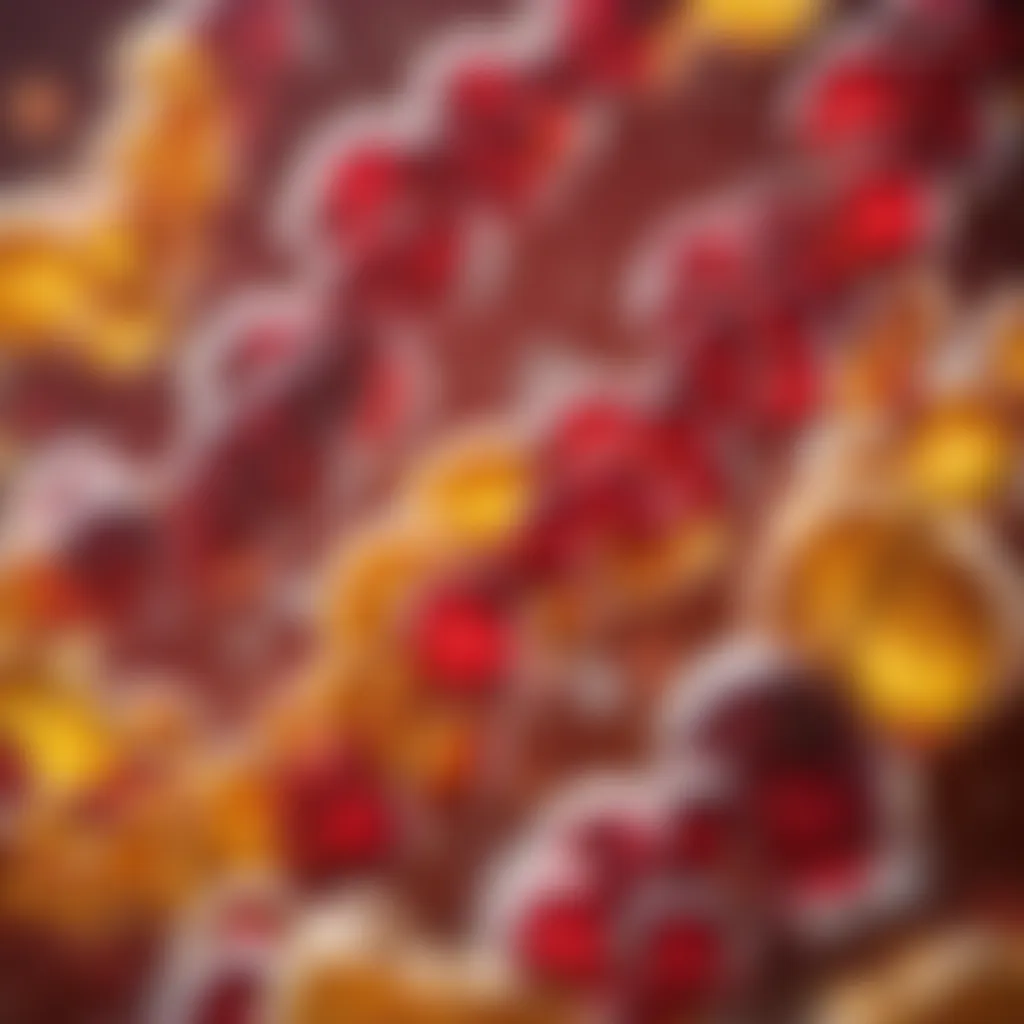Understanding RNA Later: Preservation Techniques Explained


Intro
In the realm of molecular biology, preserving RNA integrity is not just important; it's crucial. This is where the RNA Later technique comes into play. It acts like a guardian for RNA, safeguarding it from degradation in biological samples. In this article, we’ll explore the ins and outs of the RNA Later recipe, guiding you through each step as if we are preparing a gourmet dish.
The effectiveness of RNA preservation can significantly impact the outcomes of experiments, rendering the knowledge of methods like RNA Later essential for any researcher or even those just curious about molecular biology. Understanding not only the formulation but also the preparation techniques can make a world of difference when it comes to working with delicate RNA.
Ingredients:
To cook up a reliable RNA preservation solution, you’ll need the following ingredients, all measured with precision:
- Tris Buffer: 50 mM, pH 7.5
- Sodium Chloride: 1.5 M
- EDTA (Ethylenediaminetetraacetic acid): 1 mM
- Glycerol: 30% (v/v)
Preparation Steps:
Let’s dive into the detailed instructions that will guide us in preparing the RNA Later solution:
- Buffer Preparation: Start by preparing a Tris buffer. Dissolve the appropriate amount of Tris base in distilled water and adjust the pH to 7.5 using a pH meter. Important to get this right, as a wrong pH can affect the overall effectiveness of the solution.
- Add Sodium Chloride: Slowly incorporate sodium chloride into the buffer. This ingredient is vital for preserving nucleic acids and will help in maintaining the integrity of the RNA by preventing the activity of RNAses.
- Incorporate EDTA: Next, gently mix in the EDTA. This chelating agent binds to divalent metal ions which can otherwise catalyze the degradation of RNA. It’s crucial for ensuring a clean preservation.
- Glycerol Addition: Finally, combine the glycerol into the solution. Its hygroscopic properties help retain moisture in samples, further safeguarding the RNA.
- Mix Thoroughly: Use a vortex mixer or gently swirl the solution until all components are completely dissolved. You want that mixture to be homogenous.
Technical Aspects:
When dealing with RNA preservation, paying attention to specific technical details can enhance the reliability of your outcomes:
- Temperature Settings: Prepare and store your RNA Later solution at 4°C to maintain stability. If you are keeping it long-term, consider storing it at -20°C.
- Timing: While you can use RNA Later immediately after preparation, letting it sit for a couple of hours at 4°C can enhance its effectiveness slightly.
- Storage Guidelines: Ensure that your storage containers are RNAse-free, such as pipette tips and tubes specified for RNA work.
Cooking Process:
Now let’s move on to the sequential steps to ensure you create a high-quality RNA Later:
- Sample Collection: Once your solution is prepared, you can start working with your biological samples. Aim to use fresh samples whenever possible for the best results.
- Adding RNA Later to the Sample: Add an appropriate volume of RNA Later to your sample. As a rule of thumb, use at least 1 ml of the solution per 50 mg of tissue or 1 ml of cells.
- Mixing Properly: Gently invert the sample tube several times to ensure that the RNA Later penetrates the sample thoroughly, effectively freezing its RNA content in time.
- Storage: After mixing, store the samples at either -20 °C for long-term storage or 4 °C for short-term experiments.
Troubleshooting Tips:
While the process is straightforward, you may encounter some challenges. Here are some possible hiccups and how to tackle them:
- If RNA Degrading is Observed: Ensure that your working area is clean and free from RNases. This is paramount for successful results.
- Overly Viscous Solution: If you find that your RNA Later solution is too thick, it may not mix well with your sample. Consider diluting it slightly in Tris buffer before use.
- Sample Over-Saturation: Too much RNA Later may impair the extraction process. Stick to the recommended volumes.
"Proper RNA preservation isn’t just a step in the procedure, it’s a foundational block in successful molecular analysis."
In this exploration of the RNA Later recipe, we've stripped down the complexities to make them digestible. Understanding these techniques not only enhances your skills but also paves the way for potentially groundbreaking research. Embrace the details, and watch your RNA science flourish.
Prelude to RNA Preservation Techniques
In the realm of molecular biology, the preservation of RNA is a crucial aspect, much like keeping a fine wine in just the right cellar. This section sheds light on why RNA preservation techniques hold great significance and outlines the various approaches available, setting the stage for a deeper dive into the RNA Later technique.
The Importance of RNA Preservation
The integrity of RNA is a delicate affair. One could say it wears a crown of instability, making timely and careful preservation essential. RNA, or ribonucleic acid, plays a pivotal role in the expression and regulation of genes. If the RNA degrades, it becomes virtually impossible to unravel the biological stories encoded within it. This preservation is not just about silencing decay; it ensures that any ensuing analyses provide valid and reliable results.
For researchers, quality assurance hinges on effective RNA preservation. This process opens the door to robust applications in genomics, transcriptomics, and even diagnostic fields. A smattering of degradation can lead to mistruths in experiments, potentially spiraling into misguided research conclusions. In essence, proper RNA preservation is the backbone of reliable scientific inquiry.
Overview of Current Preservation Methods
When considering RNA preservation, researchers are faced with a variety of methods – each possessing its own pros and cons. Some of these methods include:


- Freezing: A common and straightforward approach, although it can damage RNA if not done carefully. The thaw-freeze cycles can be quite perilous for sample integrity.
- Lyophilization: This freeze-drying technique can be effective but requires specialized equipment. It’s not as user-friendly as other methods.
- Alcohol Preservation: Using ethanol can indeed preserve RNA, but it can precipitate salts and hinder downstream applications.
- RNA Later: This is where our focus will shift. Designed specifically to stabilize RNA in biological samples, it's both straightforward to use and efficient. It’s no wonder RNA Later has gained popularity in the scientific community.
Each method lays its strengths on the table, but not all may suit the specific demands of your samples or experiments. Understanding the nuances between these techniques is critical in choosing the right tool for the job, setting the stage for accurate results in future applications.
Understanding RNA Later
The significance of RNA Later in the realm of molecular biology cannot be overstated. It serves as a crucial tool for preserving RNA integrity, a necessity when working with biological samples. When a sample is collected, the natural degradation of RNA may begin almost instantaneously due to enzymatic activities and environmental conditions. This loss of integrity can severely affect downstream applications, such as gene expression analysis. Therefore, utilizing a preservation technique like RNA Later can effectively halt this decline, allowing researchers to obtain reliable results.
Now, let’s delve into the specifics of RNA Later. This solution is not just a random concoction; it’s been carefully formulated to stabilize RNA. Known for its significant utility across various fields, including genomics and molecular diagnostics, RNA Later facilitates the safe storage of samples at ambient temperatures without compromising the RNA quality.
The Chemistry Behind RNA Later
At its core, RNA Later operates through a sophisticated interplay of chemical principles. The main culprits behind RNA degradation are ribonucleases, enzymes that break down RNA shortly after cell lysis. RNA Later employs a unique chemistry to inhibit these enzymes, thus ensuring that RNA remains intact during the storage period.
The preservation solution contains a high concentration of salts, which create an environment unfavorable for these degrading enzymes. Additionally, the presence of certain stabilizing agents further enhances the RNA’s resistance to breakdown. The formulation provides a protective barrier around the RNA molecules, effectively neutralizing potential threats posed by ribonucleases and external factors. This chemistry not only protects the RNA but also allows it to be extracted later without significant loss of quality. The resulting integrity of the RNA extracted from samples preserved in RNA Later is typically superior to that of samples stored using traditional methods.
Key Components of the RNA Later Recipe
Creating your own RNA Later mixture involves specific ingredients that work together harmoniously to ensure optimal preservation. Understanding these components sheds light on why this recipe is successful in maintaining RNA stability.
- Water: The primary solvent, free from ribonuclease contamination.
- Sodium chloride: Essential for creating an ionic strength that stabilizes nucleic acids.
- Tris base: Helps maintain a stable pH, crucial when storing delicate RNA.
- EDTA (Ethylenediaminetetraacetic acid): A chelating agent that binds divalent metal ions, which are necessary cofactors for many enzymes including ribonucleases.
Here’s a simple breakdown of a typical RNA Later recipe:
When combined correctly, these components not only work effectively to preserve RNA but also reduce the risk of contamination. The balance of each ingredient is crucial—too much of one can lead to adverse effects on RNA, while too little might not provide the necessary protection.
Using RNA Later as a preservation method dovetails into broader research goals, ensuring that any findings and conclusions drawn from analyses stand on a solid foundation of integrity and reliability.
Formulating RNA Later
When it comes to protecting RNA integrity in biological samples, the formulation of RNA Later is pivotal. This solution acts as a safeguard, ensuring that RNA remains stable and intact from the moment of collection until analysis. Understanding this preparation not only aids in proper usage but also provides insights into the careful balance of ingredients needed for effective preservation.
The key elements of the RNA Later recipe come from a blend of various components, each chosen for their unique properties. These components all play a part in inhibiting RNA degradation, a crucial factor often overlooked in molecular biology. Moreover, a precise formula allows researchers and enthusiasts alike to create their own batch, ensuring that they always have the right tools at their disposal for preserving RNA.
Step-by-Step Preparation Guide
To ensure success in formulating RNA Later, follow these meticulous steps:
- Gather Ingredients: You will need:
- Mix the Components:
- Adjust pH: Check the pH of your mixture. It should ideally be around 7.0. Use a pH meter or pH paper for accuracy. If adjustments are necessary, utilize either concentrated HCl or NaOH solutions.
- Dilution with Distilled Water: After ensuring the pH is correct, dilute your mixture to the desired volume with distilled water. This gives you your RNA Later solution.
- Sterilization: To avoid contamination, it's recommended to autoclave the solution or filter it through a 0.22-micron filter.
- Storage: Once cooled to room temperature, transfer your solution into clean, sterilized containers. Label each clearly with its concentration and the date prepared.
- 0.1 M sodium citrate
- 0.5 M sodium chloride
- 10 mM EDTA (pH 8.0)
- Distilled water
- Optional: Glycerol to enhance the stability of the solution
- Start by adding 0.1 M sodium citrate to a container.
- Gradually blend in 0.5 M sodium chloride and 10 mM EDTA. Make sure to stir consistently to help dissolve any solids.
- If you wish to enhance stability, add glycerol in a ratio of 1:5 (glycerol to other liquids).
Storage Conditions for RNA Later Solutions
Storing your RNA Later solution correctly is just as important as its preparation. The stability of the solution is affected by temperature and exposure to light. Here's how to ensure optimal preservation:
- Temperature: RNA Later solutions should be stored at temperatures below 25°C. For long-term storage, keeping it in a freezer at -20°C is recommended.
- Avoiding Freeze-Thaw Cycles: Repeated freeze-thaw cycles can degrade the solution's integrity. Make small aliquots that can be used individually, minimizing the need to thaw the entire batch.
- Protection from Light: Storing the solution in amber-colored containers can protect it from light degradation, maximizing its storage life.
By paying attention to these storage conditions, you can enhance the longevity and effectiveness of your RNA Later solutions, ensuring reliable performance whenever needed.
Application of RNA Later in Research


Understanding how RNA Later is used in molecular biology research cannot be understated. The efficacy of the RNA Later technique is pivotal when accuracy in RNA analysis is essential. Many researchers find themselves facing the daunting task of preserving RNA samples for various applications. The contribution of RNA Later in this process offers advantages that cannot be ignored.
RNA Extraction Procedures
When it comes to isolating RNA, the method of extraction significantly influences the quality and integrity of the final product. RNA Later streamlines this process. After biological samples are immersed in RNA Later solution, they can be shipped and stored without immediate processing. This has huge implications for laboratories far and wide because samples can be collected in the field and sent directly to research facilities.
- Sample Collection: Gather your biological samples with careful attention to minimize degradation. The use of sterile tools ensures a clean collection.
- Immersion: Submerge samples in RNA Later immediately after collection. This quick step helps maintain RNA integrity.
- Storage: Store samples at 4 °C for short-term use or at -80 °C for longer durations. This ensures that the RNA remains intact until you're ready for extraction.
- Extraction Steps: Follow standard protocols according to the extraction kit you’re using, such as TRIzol or a column-based kit. Adherence to these procedures will yield high-quality RNA
- Quality Assessment: Utilize spectrophotometry or gel electrophoresis to assess RNA purity and concentration, ensuring the sample is optimal for downstream applications.
The simplicity of this method reduces the chance for contamination and error, thus providing fewer headaches down the line.
Applications in Genomics and Transcriptomics
The world of genomics and transcriptomics offers exciting avenues for research, and RNA Later plays a critical role in facilitating these undertakings. By maintaining the stability of RNA, researchers can delve into complex gene expression studies without fearing that sample degradation will skew their findings. Here’s how RNA Later integrates into these fields:
- Gene Expression Analysis: With high-quality RNA preserved in RNA Later, researchers can accurately analyze gene expression patterns. This is fundamental for understanding diseases at a molecular level.
- Metatranscriptomics: In studying microbial communities, RNA Later aids in preserving microbial RNA, which is crucial for understanding community dynamics in various environments.
- Longitudinal Studies: For studies that track changes over time, RNA Later allows for extended sample viability, enabling researchers to revisit samples collected at different time points.
- Precision Medicine: The ability to analyze RNA effectively contributes to tailored treatments based on molecular profiles, making this preservation technique relevant in the pursuit of personalized medicine.
In summary, RNA Later is not just a solution; it’s a resource that enables robust applications in genomics and transcriptomics. By addressing the critical needs of RNA preservation, it empowers researchers to advance our understanding of biological systems with confidence and precision.
"The stability and reliability of RNA samples preserved with RNA Later creates a solid foundation for groundbreaking discoveries in molecular biology."
Comparative Analysis of RNA Later
In the world of molecular biology, the techniques employed in preserving RNA are pivotal. Understanding how RNA Later stacks up against other preservation methods not only shines a light on its unique strengths but also illuminates its shortcomings. This comparative analysis serves as a guide for researchers, helping them make informed decisions about which techniques to employ based on specific needs and sample types.
Comparing RNA Later with Other Preservation Methods
When researchers look at options for RNA preservation, they often find themselves at a crossroads. Formaldehyde, for instance, has long been a mainstay in the biological realm. However, where formaldehyde preserves nucleic acids adequately, it can introduce changes in the RNA, which might not be ideal for all analyses. Alcohol-based solutions, such as ethanol and isopropanol, present another option. They are effective in deactivating ribonucleases and ensuring RNA stability over time, but they can also cause precipitation of RNA and, subsequently, the loss of some RNA fragments.
On the other hand, RNA Later takes the cake for both ease of use and efficacy. Derived from proprietary formulations, it effectively stabilizes RNA integrity while minimizing the risk of degradation. While many common methods require extensive steps for sample preparation, RNA Later conveniently allows for immediate addition post-sampling, streamlining the process.
To summarize the comparison:
- Formaldehyde: Effective but may alter RNA structure, less desirable for sensitive applications.
- Alcohol-based solutions: Good for quick fixes; however, RNA precipitation might compromise yield.
- RNA Later: Quick application, preserves integrity with minimal hassle, and ensures reliable results, especially in downstream analyses.
Advantages and Limitations of RNA Later
Advantages:
- Simplicity of Use: One of the hallmarks of RNA Later is its straightforward application. Just add it to your sample, and you’re set.
- Strong RNA Preservation: Studies show that this method excels in maintaining RNA integrity, crucial for sensitive downstream applications such as PCR and sequencing.
- Temperature Tolerance: RNA Later demonstrates remarkable temperature resilience, allowing samples to remain stable in various conditions.
- Versatility: This preservation technique can be utilized across a range of tissue types, making it a jack-of-all-trades for many biological samples.
"RNA Later bridges the gap between hassle-free sampling and high RNA quality, making it indispensable in molecular studies."
Limitations:
- Cost: While the benefits are significant, RNA Later can be more expensive than traditional methods.
- Sample Size Constraints: For very large samples, finding an appropriate quantity of RNA Later can pose challenges.
- Not Universally Applicable: In some circumstances, other methods might outperform RNA Later, depending on research specificities and goals.
Troubleshooting Common Challenges
When delving into the intricacies of RNA preservation, particularly with the RNA Later technique, effective trouble-shooting becomes paramount. The delicate nature of RNA means even the smallest misstep during the preservation process can throw a wrench in your plans. This section aims to shine a light on common challenges you might encounter and how recognizing potential pitfalls can save you a great deal of heartache later down the line.
Identifying Potential Issues in RNA Preservation
Certain factors can negatively impact the preservation of RNA in your samples. For instance, improper handling before preservation may lead to degradation. This degradation can stem from a lack of immediate cooling or exposure to unwanted environmental conditions. Here’s a closer look at some potential issues you might face:


- Temperature Fluctuations: RNA is exquisitely sensitive to temperature. If your samples are not cooled quickly enough, there may be a risk of degradation. Detecting a delay in cooling can signal a potential problem.
- Contamination: Anything from fingertips to compromised reagents can contaminate your samples. Following strict aseptic techniques during sampling is crucial.
- Inadequate Volume of RNA Later: An insufficient amount of RNA Later can lead to incomplete coverage of the sample, risking degradation. Ensure you follow the recommended guidelines on the volume proportional to your sample size.
- Improper Storage Conditions: After using RNA Later, if the RNA is not stored under optimal conditions, stability can be compromised. Storing in fluctuating temperatures or if it’s exposed to light can have detrimental effects.
By familiarizing yourself with these potential roadblocks, you’ll be better equipped to realize when something might be amiss.
Solutions and Recommendations
Every issue has a solution waiting to be found. Here are some recommendations to help you navigate common challenges while preserving RNA effectively:
- Ensure Rapid Cooling: As soon as your sample is collected, quickly place it in RNA Later and store it at low temperatures. If working in warm environments, keep ice packs handy to expedite cooling.
- Practice Sterile Techniques: Use gloves and sterile instruments to handle your samples. A little precaution goes a long way in preventing contamination.
- Follow Volume Guidelines: Make sure you use the right amount of RNA Later for each sample. Keeping the manufacturer's instructions at hand can mitigate the risk of inadequate coverage.
- Optimize Storage: Store your RNA Later-preserved samples in a consistent, low-temperature environment, ideally at -20°C or -80°C. Avoid partial thawing, and don’t expose your samples to light unnecessarily.
Proper care in these areas not only preserves the quality of RNA but also enhances the reliability of your research findings.
Through proactive monitoring and addressing these common challenges, you can ensure that the integrity of your RNA samples remains intact. This diligence pays dividends in your downstream applications, leading to insightful and conclusive results.
Impact of RNA Preservation on Downstream Applications
RNA preservation plays a pivotal role in the realm of molecular biology. When any biological sample is collected, there’s always a risk that the integrity of the RNA may be compromised. If the RNA isn’t preserved properly, it can lead to inaccurate results in various downstream applications, potentially skewing the data scientists and researchers rely on. By investigating how RNA preservation impacts subsequent analytical steps, we can understand the consequences of compromised RNA and the importance of proper preservation like RNA Later.
Influence on Gene Expression Studies
Gene expression studies hinge on the ability to accurately analyze RNA levels at a given time. RNA Later works wonders by immobilizing the RNA effectively, allowing it to retain its integrity even under less-than-ideal conditions. What does this mean down the line? Well, when RNA samples are efficiently preserved, any subsequent analysis, like quantitative PCR or microarray studies, is more likely to yield reliable data. This is crucial because any variation in gene expression can have significant biological implications.
For instance, if you’re studying a disease marker in a particular tissue, the RNA extracted from that tissue can reveal insights into the gene activity related to disease progression. If the RNA is degraded, you risk misinterpreting the gene's expression levels. This misrepresentation could lead research in the wrong direction, raising concerns over the data’s integrity.
Additionally, studies frequently involve multiple comparisons of gene expressions under different conditions or treatments. Therefore, ensuring RNA preservation with techniques like RNA Later increases the reliability of those comparisons, ultimately supporting stronger conclusions and better-informed decisions based on those findings.
Effects on PCR Amplification Efficiency
PCR (Polymerase Chain Reaction) is a fundamental technique used to amplify specific DNA sequences, and its success greatly depends on the quality of the initial RNA sample. When RNA is degraded, this can have a cascading effect. Essentially, broken RNA strands can lead to subpar cDNA synthesis, which in turn affects the efficiency of PCR amplification.
When RNA Later is used for preservation, it minimizes the degradation timeframe. This means that the RNA remains intact, providing a solid foundation for downstream applications. Enhanced PCR efficiency can lead to clearer, more distinct results, and can even affect the quantification measures obtained from these amplifications. It’s nearly like cooking: if you start with rotten ingredients, your dish will inevitably suffer.
To sum it up, the effects of RNA preservation on PCR are significant:
- Increased yield: Quality RNA leads to better cDNA libraries.
- Sensitivity: Well-preserved RNA enhances the detection rates of low-abundance transcripts.
- Accuracy: Maintaining integrity allows for refined and trustworthy results.
- Reproducibility: Reliable data fosters confidence in repeat studies or experiments.
"The essence of RNA preservation isn't just about maintaining samples; it's about safeguarding the validity of the entire research process."
By ensuring that RNA is preserved effectively from the outset, the downstream applications become far more predictable and reliable, offering researchers confidence in their findings. Therefore, the impact of RNA preservation, particularly through methods like RNA Later, is indispensable in the world of genetic research.
Future Directions in RNA Preservation Research
The realm of RNA preservation is undergoing a fascinating transformation as scientists continue to push the boundaries of what is possible. It's more than just about keeping your biological samples intact; it involves improving the quality and utility of the preserved RNA for revolutionary research and applications. The future of RNA preservation research is pivotal because it can significantly influence genetic studies, drug development, and even personalized medicine. Enhancing RNA stability opens up new horizons in understanding gene functions and expressions, which can ultimately lead to breakthroughs in various biological fields.
Innovations in RNA Preservation Techniques
In recent years, the landscape of RNA preservation techniques has seen a slew of innovative approaches. Researchers have begun exploring a range of methodologies beyond the classical approaches. Here are some cutting-edge techniques that are making waves:
- Cold Storage Solutions: While traditional refrigeration is common, newer solutions are being developed that allow for longer stability at colder temperatures without compromising RNA quality.
- Nano-Particle Stabilization: Employing nanotechnology to encapsulate RNA molecules offers protection against degradation from environmental factors.
- Cryopreservation Advancements: Improved protocols for cryopreservation have emerged, aiming to enhance the survival and functionality of the RNA after thawing.
- Chemical Modifications: Certain chemical additives can be included in preservation solutions, dramatically increasing the shelf life and usability of RNA.
These innovations not only enhance the preservation process itself but also improve the overall quality and utility of the RNA extracted later on. For researchers, this means less variability in results and more reliable data.
Potential for Novel Applications in the Field
The implications of advancing RNA preservation techniques extend far beyond merely storing biological samples. Here are some potential novel applications that could emerge from these advancements:
- Personalized Medicine: Enhanced RNA preservation can facilitate better identification of biomarkers for individual patients, tailoring treatments at a genetic level.
- Environmental Monitoring: With effective RNA preservation methods, researchers can analyze environmental samples for microbial RNA, acting as early indicators for ecological changes and stresses.
- Agricultural Biotechnology: Improving RNA techniques can lead to better genetic modification strategies aimed at crop improvement and resilience against pests or diseases.
- Forensic Science: In the realm of forensics, superior RNA preservation could yield more accurate results in criminal investigations and post-mortem analyses.
"The future of RNA preservation is extensive; it’s not just about protection, but harnessing the true power of RNA to unlock discoveries across fields."
The study and application of RNA preservation are not static; as technology progresses, the methodologies will surely adapt. This ongoing evolution is what makes RNA preservation such a vital area in molecular biology and beyond. By investing in innovative approaches, there's the potential to substantially elevate our understanding and manipulation of RNA, directly impacting scientific and medical progress.







